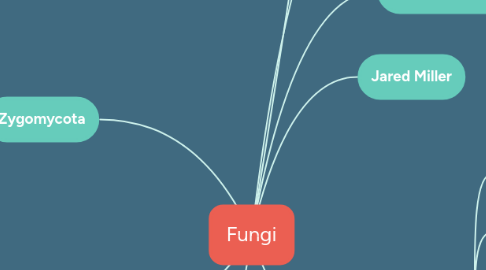
1. Chytridiomycota
1.1. Example: Batrachochytrium dendrobatidis
1.2. Unique for having flagellated spores called "zoospores"
1.3. Can be decomposers, parasites, or mutualists
2. Glomeromycota
2.1. Example: Gigaspora margarita
2.2. Primarily form arbuscular mycorrhizae
2.3. Originally considered zygomycetes, but moved to separate clade
3. Zygomycota
3.1. Example: Spiromyces
3.2. Zygosporangia: site of karyogamy and meiosis. Produces zygospores that are used for reproduction
3.3. Can be decomposers, parasites, or mutualists
4. Ascomycota
4.1. Example: Cladosporium
4.2. Commonly called "sac fungi"
4.3. Produce sexual spores in saclike asci containing fruiting bodies ascocarps, which contain ascospores
4.4. Produce asexually at the tips of specialized hyphae called conidiophores
4.5. Can be decomposers, parasites, or mutualists
5. Basidiomycota
5.1. Example: Boletales
5.2. Commonly called "club fungi"
5.3. Defined by clublike structure called a basidium (containing basidiocarp and basidiospores), a transient diploid stage in the life cycle
5.3.1. Basidiocarp: "gills" underneath basidium
5.3.2. Basidiospores: sexual spores that grow in basidiocarp "gills"
5.4. Some species produce "fairy rings": mushrooms forming a circle around the central growth point
5.5. Can be parasites or mutualists, many decompose wood
6. Lichen
6.1. Example: Risocarpen geographica
6.2. A symbiotic association between a photosynthetic microorganism and a fungus
6.3. Photosynthetic cells are help in fungal hyphae
6.4. Fungal organism is most often an ascomycete
6.5. Reproduce either by fragmentation or formation of soredia
6.5.1. Soredia: small clusters of hyphae with embedded algae
6.6. Foliose: one of the varieties of lichen, characterized by flattened, leafy look, and upper and lower cortex
6.7. Fruticose: one of the varieties of lichen, characterized by bushy structure
6.8. Crustose: when lichen grows tightly in a layer on a host plant or rock
6.9. Photosynthetic organism is either a green algae or cyanobacteria
6.9.1. Green algae: provide carbon compounds
6.9.2. Cyanobacteria: provide carbon compounds and sometime organic nitrogen
7. General fungi traits
7.1. Absorptive heterotrophy: uses enzymes to break down complex molecules into smaller organic compounds
7.2. Body structure
7.2.1. Body structure is often either multicellular filaments or single cell yeasts
7.2.2. Cell walls made up of chitin
7.2.3. Pileus: the technical name for the cap of a basidiocarp or ascocarp
7.2.4. Stipe: the stem/stalk supporting the pileus
7.2.5. Gills: found under pileus, used as a means of spore dispersion
7.3. About 30% are parasites or pathogens
7.3.1. Ergot or rye: ascomycete that produces toxins
7.3.2. Mycosis: general term for fungal infection in animals
7.3.2.1. Systemic mycosis: infections that spread throughout the body
7.3.2.2. Opportunistic: yeast infections
7.4. Practical uses of fungi
7.4.1. Eating
7.4.2. Treatment of bacterial infections
7.4.3. Making cheeses, alcoholic beverages, and bread
7.5. Mycelium: networks of branched hyphae used for absorption
7.5.1. Septate fungi: cell-to-cell movement in hyphae is controlled by pores between cells in hyphae
7.5.2. Coenocytic fungi: lack septa, and so movement in hyphae is totally unrestricted
7.5.3. Haustoria: specialized hyphae designed to penetrate host tissues
7.6. Mycorrhizae: mutually beneficial relationships between fungi and plant roots
7.6.1. Ectomycorrhizal fungi: form sheaths of hyphae over roots and grow into extracellular spaces in roots
7.6.2. Arbuscular mycorrhizal fungi: penetrate cell walls of root cells
7.7. Reproductive cycle
7.7.1. Sexual reproduction follows the steps of plasmogamy, heterokaoyotic stage, and karyogamy, meiosis, and germination
7.7.1.1. Plasmogamy: fusion of the cytoplasm but not the nuclei
7.7.1.2. Heterokaryotic stage: the time between plamogamy and karyogamy, can last for days or centuries
7.7.1.3. Karyogamy: fusion of the nuclei
7.7.1.4. Meiosis: production of daughter cells with individualized genetic material
7.7.1.5. Germination: the paired processes of karyogamy and meiosis producing genetic variation
7.7.2. Asexual reproduction
7.7.2.1. Molds: produce haploid spores by mitosis and form visible mycelia
7.7.2.2. Yeasts: reproduce via cell division by "pinching off" bud cells from a parent cell
7.7.3. Deuteromycetes: molds and yeasts with no known sexual stage
